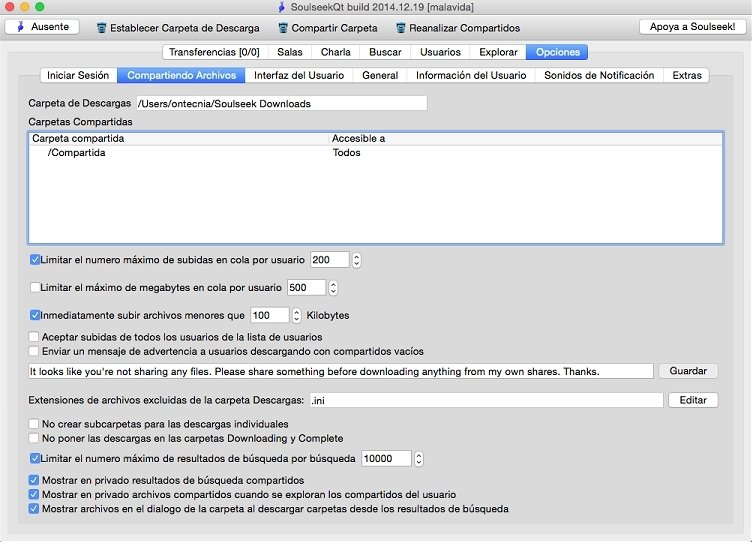
This section is often used to specify a their personal sharing rules by senior users. Here, you can write something about yourself, and upload a picture if you want to. – “ Clear Search History” does exactly that, and “ Chat Filter Words” is for people who don’t like foul language and would like to have the chat “beep” some words. – You won’t need “ Enable user-level logging (only for special debugging purposes)” in most cases.
Soulseekqt mac code#
– “ Code Page to use translate non-Unicode characters” is handy if you like to download files with names in non-latin letters (Chinese, Russian and various other asian languages).

– “ Log room chat” and “ Log private chat” keeps logs of your chats it saves it to your computer.
Soulseekqt mac software#
– “ Automatically toggle away mode when idle” is handy if you often use the Soulseek community features and would like the software to automatically show this to other users after you leave the computer idle for a while. – “ Save client data every x minutes” changes how often Soulseeks runs a backup of your personal settings, such as friend lists. – “ Show uploads and downloads in the same tab” merges both upload and download tab into one, not something we like a lot as it makes things messy. – “ Use old-style transfers view” and “ Use old-style search results” removes the tree-like structure of either of both the new one is way more practical though, we recommend you don’t use these.
Soulseekqt mac windows#
– “ Show tray icon” can be unchecked to remove the tray icon in the lower right corner of your windows task bar, in case you don’t want it to be displayed. Only three of these options are important in our opinion: This tab changes some details in the clients appearance and, sometimes, layout. – “ Show files in folder dialog when downloading folders from search results“: N/A (we’re not currently sure, but looking into it) UI – “ Show privately shared files when browsing user shares“: When browsing a users shares, you can either opt to only show files you can freely download (publicly shared), or also display results the user is only sharing with his friend list. If you don’t want to go through the hassle, you can uncheck it, but this will hide some potentially interesting search results. Choose this if you have no problem with asking people for permission to get their files. – “ Show privately shared search results“: Shows you files in the search results the user only shares with people on his friend list, and that might not be accessible for you. – “ Limit maximum number of search results per search”: Caps the amount of search results to the selected number. – “ Don’t put downloads in Downloading and Complete folders“: N/A (we’re not currently sure, but looking into it) Uncheck this to save single track downloads to the main folder instead. – “ Don’t create subfolders for single downloads“: Normally, when downloading a file, Soulseek will automatically create subfolders, containing the artist, album and so on. The same goes for “ Limit maximum megabytes of queued uploads per user“. Doing so stops them from jamming your upload slots, or just aimlessly downloading your entire share. – “ Limit maximum number of queued uploads per user” puts a limit on how many of your files users can queue up to be downloaded from you. Both can be changed with the buttons on the upper menu bar.

– “ Download Folder” is the folder your downloads get saved to, and “ Shared Folders” is a list of folders that you share with others. A more pedantic user can control almost anything from here. Here, you can configure exactly what and how you share files.
Soulseekqt mac password#
Keep in mind this password should be uniquely used for Soulseek, as it might not be saved securely on the Soulseek servers. There, you can also change your password by clicking “ Change Passwort“.

(The upper bar allows you to change both listening port and your nickname)

You can leave it as it is in most cases, no need to change anything about it. – “ Server port” is the port under which Soulseek contacts the central server. As a bonus, you don’t have to change any of your routers configuration when going this way. Important: If you want to forward ports and use a VPN for privacy and anonymity (we strongly recommend you do), just use a VPN with port forwarding. For more information, consult our guide on port forwarding. – “ Use UPnP port mapping” and “ Use NAT-PMP port mapping” should both be checked, as it automatically forwards ports if your router and/or firewall allow this.


 0 kommentar(er)
0 kommentar(er)
